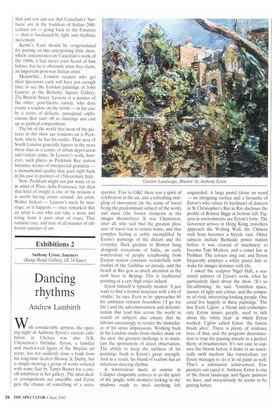Exhibitions 2
Anthony Eyton: Journeys (Kings Road Gallery, till 24 June)
Dancing rhythms
Andrew Lambirth
With considerable aptness, the opening night of Anthony Eyton's current exhibition in Chelsea was also G.K. Chesterton's birthday. Eyton, a familiar and much-loved figure of the Mayfair art scene, has not suddenly done a bunk from his long-time dealers Browse & Darby, but is simply showing a group of works selected with some flair by Tanya Baxter for a oneoff exhibition at her gallery. The inter-dealer arrangements are amicable, and Eyton gets the chance of something of a retro
spective. True to GKC there was a spirit of celebration in the air, and a refreshing mingling of movement (in the sense of travel being the predominant subject of the work) and stasis (the frozen moments in the images themselves). It was Chesterton, after all, who said that the greatest pleasure of travel was to return home, and that complex feeling is nobly exemplified by Eyton's paintings of the distant and the everyday. Back gardens in Brixton hang alongside evocations of India, an early watercolour of people telephoning from Euston station contrasts wonderfully with studies of the Gurkhas on parade, and the beach at Rio gets as much attention as the rush hour in Beijing. This is traditional painting of a very high order indeed.
Eyton himself is typically modest: 'I just want to find a formal structure with a bit of vitality,' he says. Even as he approaches 80 his ambition remains boundless (I go for life') and the adventurousness and determination that lead him across the world in search of subjects also ensure that he labours unceasingly to render the immediacy of his sense impressions. Working back in his London studio from studies made on the spot, the greatest challenge is to maintain the spontaneity of direct observation. The ability to keep the surfaces of his paintings fresh is Eyton's great strength. And as a result, his brand of realism has an infectious dancing rhythm.
A watercolour made at sunrise in Udaipur eloquently conveys to us the spirit of the jungle, with monkeys lurking in the shadows ready to steal anything left unguarded. A large pastel (done on wood — an intriguing surface and a favourite of Eyton's who values its hardness) of dancers in St Christopher's Bar in Rio discloses the profile of Ronnie Biggs at bottom left. Figures in environments are Eyton's forte. The Governor arrives in Hong Kong, travellers approach the Wailing Wall, the Chinese rush hour becomes a bicycle race. Other subjects include Bankside power station before it was cleared of machinery to become Tate Modern, and a camel fair at Pushkar. The colours sing out, and Eyton frequently employs a white pastel line to make his images shimmer with life.
I asked the sculptor Nigel Hall, a seasoned admirer of Eyton's work, what he particularly liked about the show. 'It's so life-affirming,' he said. 'Limitless space, masses of light and colour, and the company of vivid, interesting-looking people. One could live happily in these paintings.' The late Euan Uglow, a friend and contemporary Eyton misses greatly, used to talk about the 'white heat' at which Eyton worked. Uglow called Eyton 'the fastest brush alive'. There is plenty of evidence here of that, and the poignant determination to trap the passing minute in a perfect flurry of brushstrokes. It's not easy to capture the bloom before it fades in an essentially swift medium like watercolour, yet Eyton manages to do it in oil paint as well. That's a substantial achievement. Few painters can equal it. Anthony Eyton is one of the finest landscape and figure painters we have, and miraculously he seems to be getting better.






















































































 Previous page
Previous page